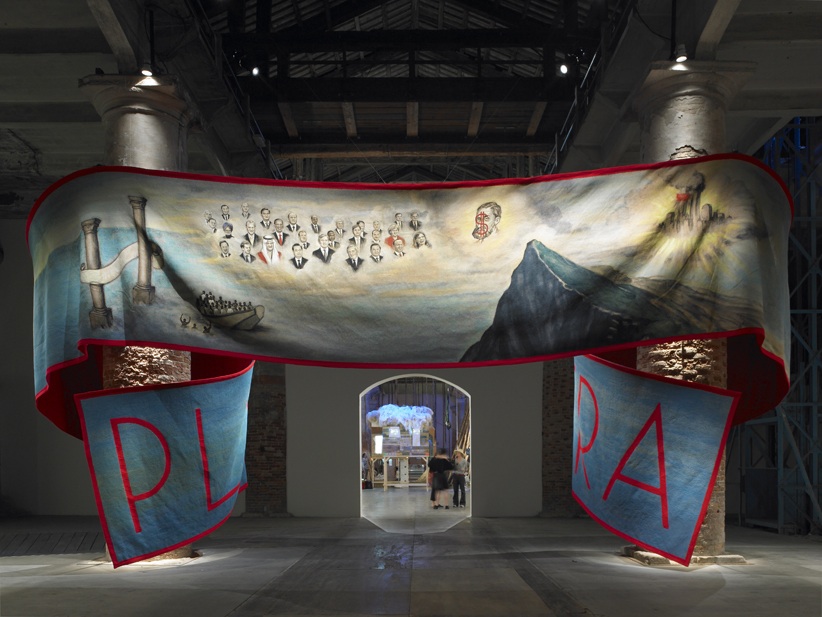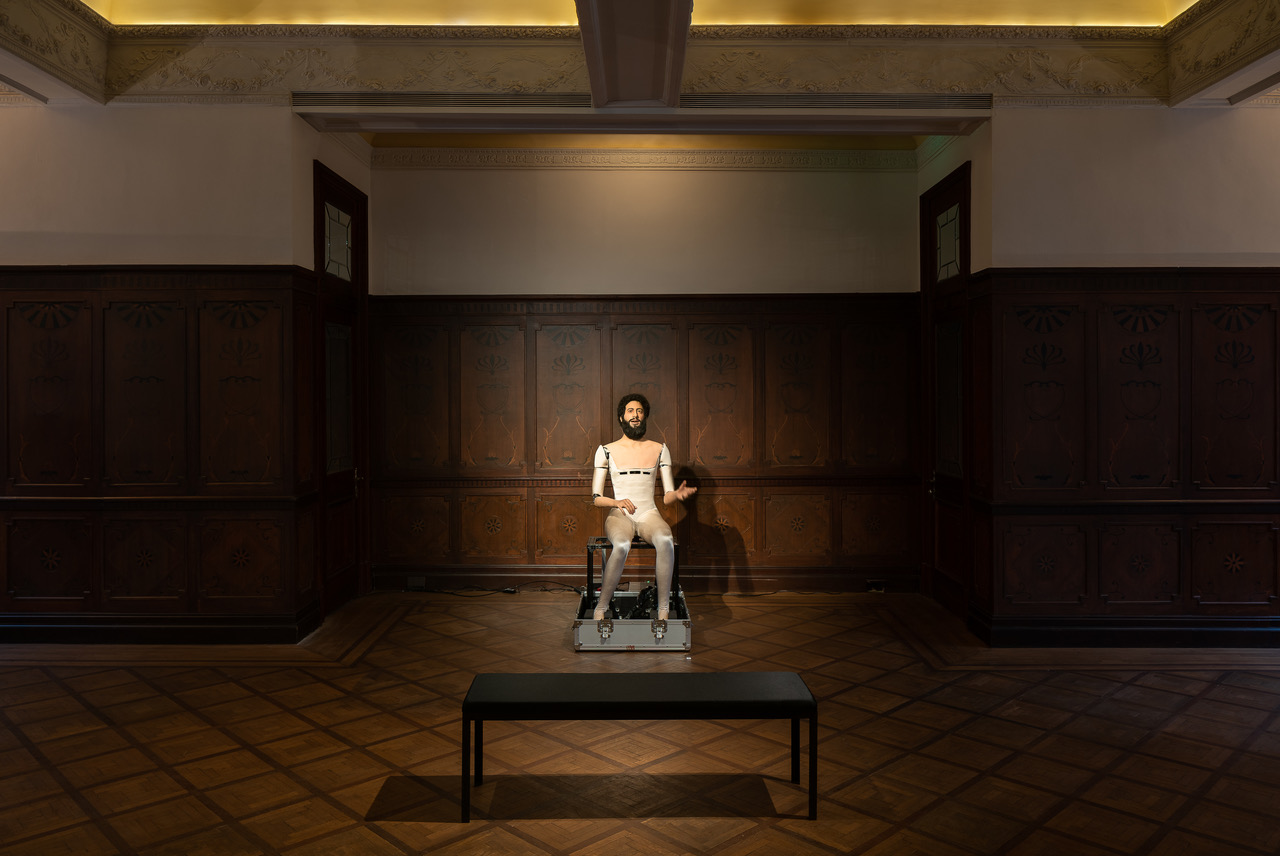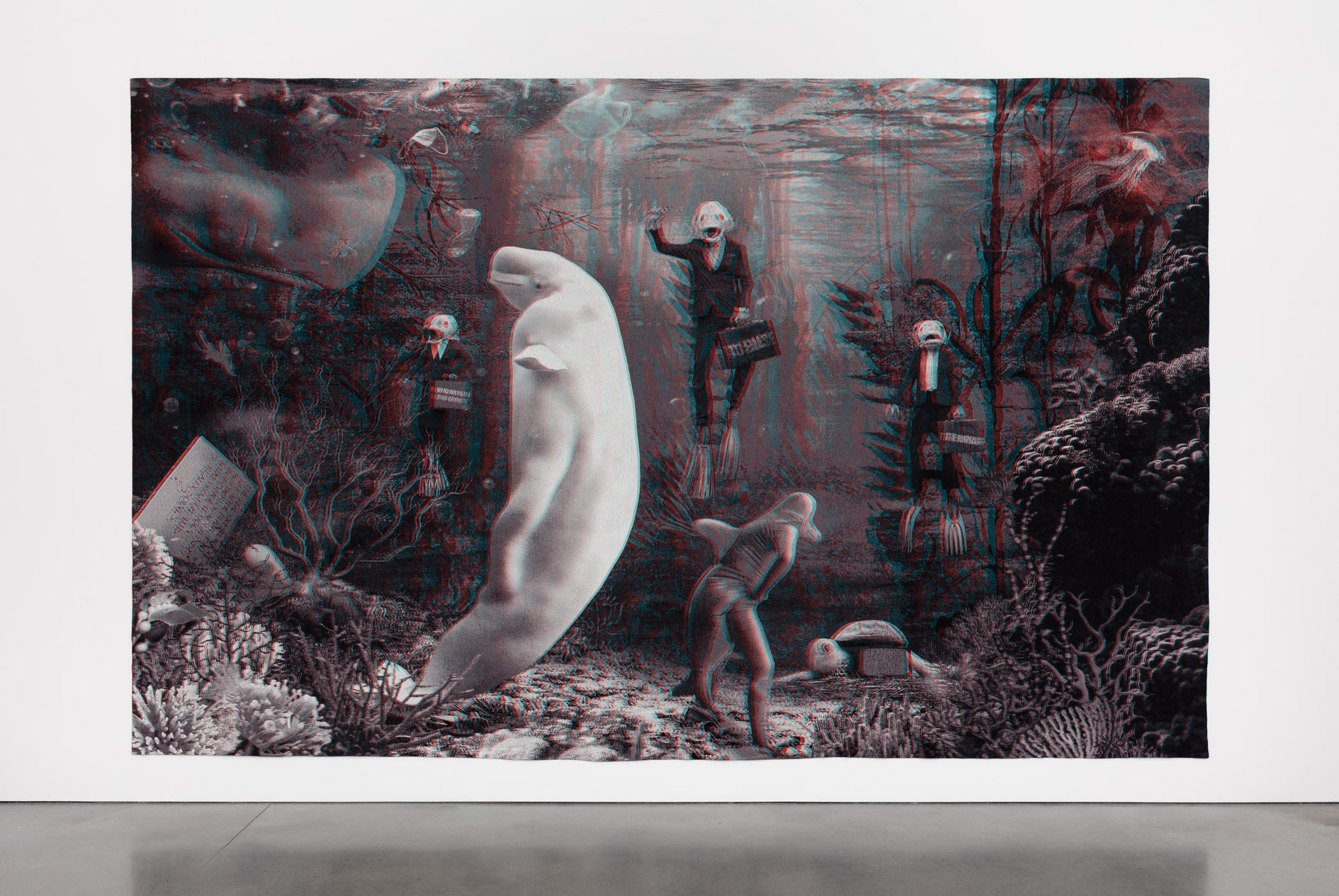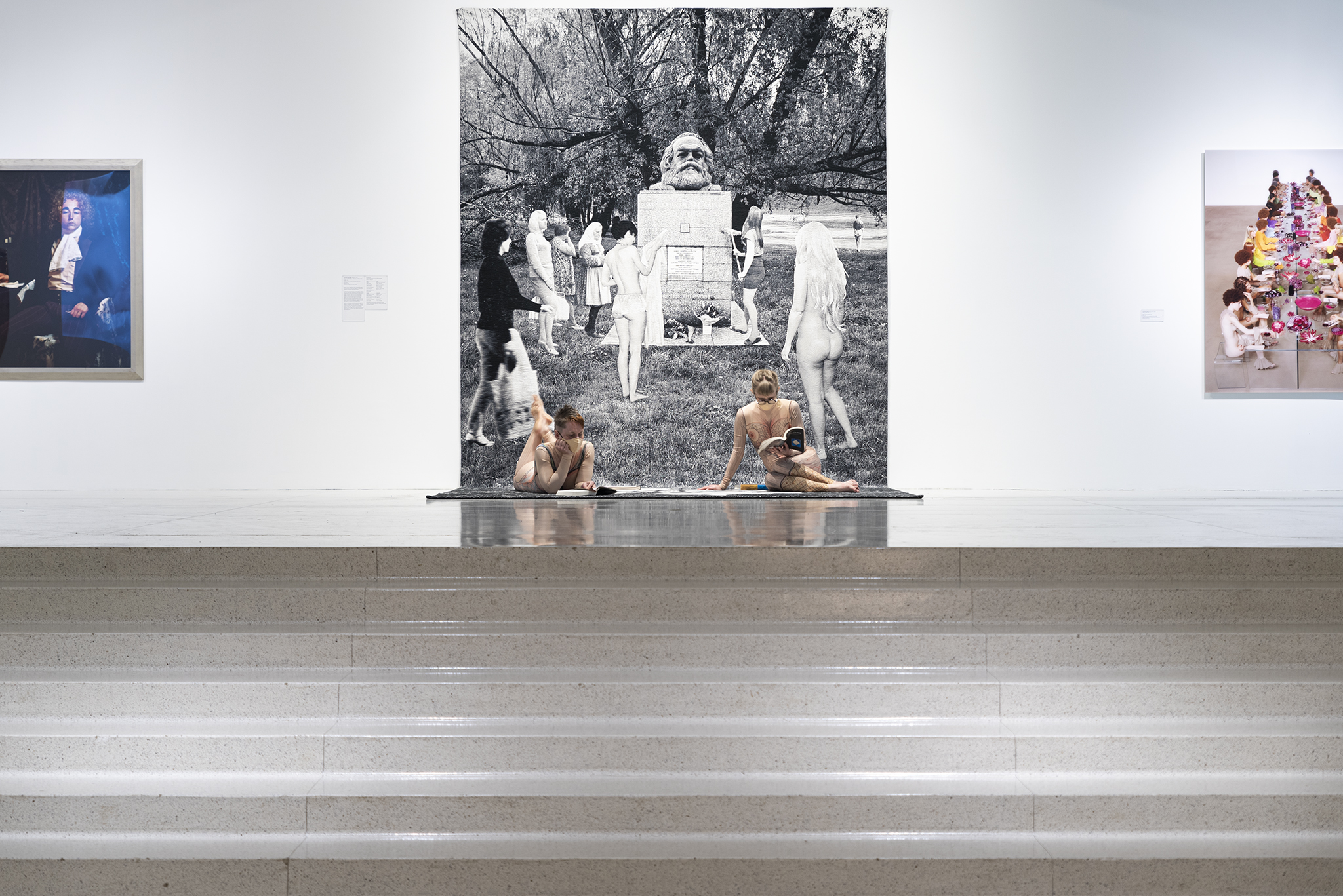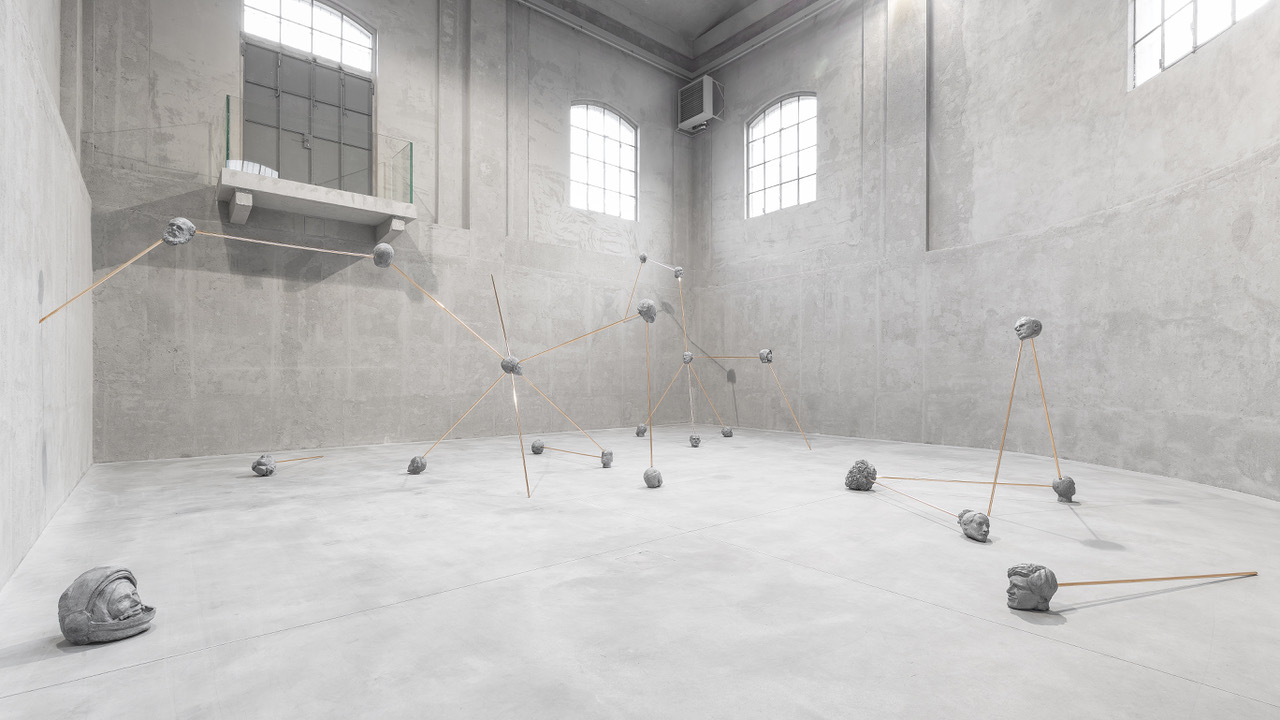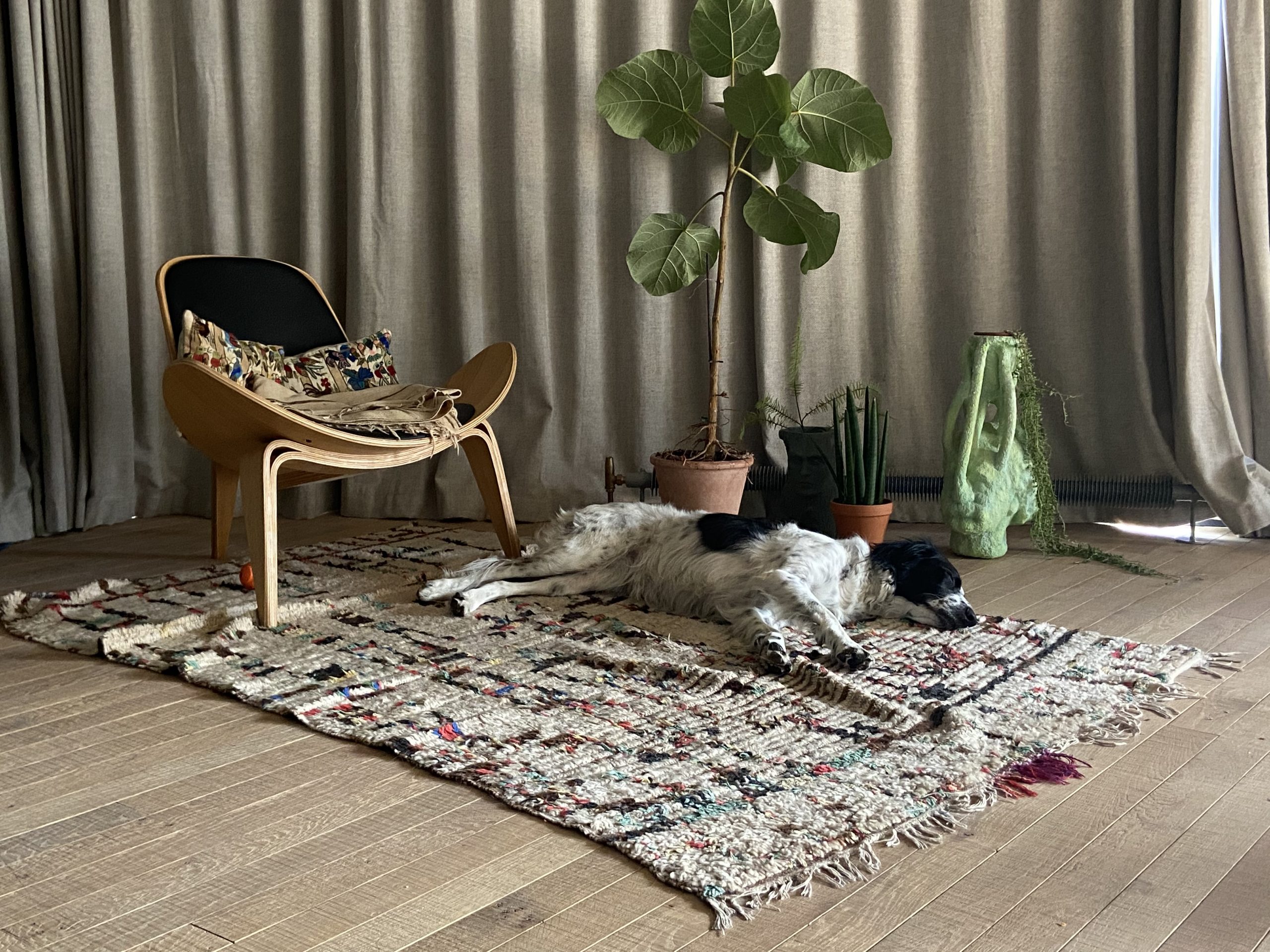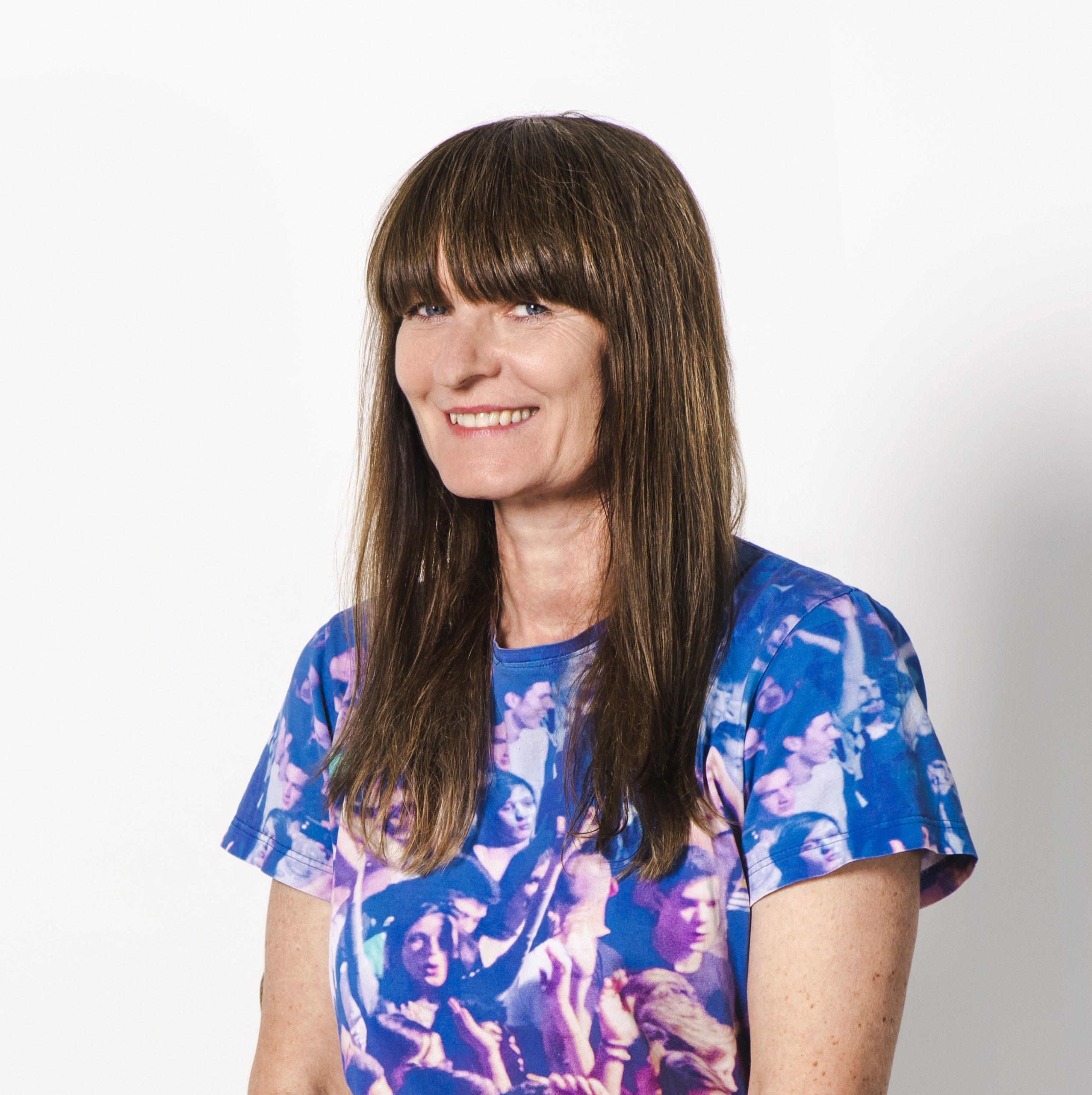
Features #15— January 2023
GOSHKA MACUGA IN CONVERSATION WITH NICOLAS VAMVOUKLIS
Hello Goshka! Are you in your studio right now? Could you describe to me what is there in front of you?
I am looking at a painting of Eileen Agar that has been hanging in my studio for years.
Most of the artworks in my collection are either the remains from past exhibitions, gifts, or a result of an exchange between other artists and me. I have rarely bought art, and Eileen Agar’s painting is such an example. I have always had a great sentiment for her work, and it was amazing to find that a few of her works were still available to buy. I thought these kind of works were much more something you could encounter in a museum rather than something you could actually buy.
In the composition of the painting, all the elements have a potential symbolic meaning. At the time she made it, Agar had visited a Tutankhamun exhibition at the British Museum, and so the work could have been influenced by it. I have a statement with all potential references of this work that was sent to me by the gallery. I am totally fascinated by it. But I don’t think the painting is based on deep research as she made work in a spontaneous and free way, not like me going through books and self-invented investigations. I think it’s quite transparent in the painting how she assembled things – it’s much more intuitive.
I scrutinise this work endlessly – like everything in my surroundings. If you ask me to describe the painting from left to right, bottom to top, without looking at it, I could just give you a brief description, but I can’t fully memorise it. It’s an exciting relationship with an object – when you can explore it but never completely capture it. This is what really drew me to this painting. It’s an endless discovery, and it looks fresh and contemporary even after half a century.
Is there Greka with you now? I adore how she features in your work in the most unexpected ways. I’ve heard you rescued the dog here in Greece a couple of years ago and that also you own property on an island. Would you consider moving in such an insular context?
Greka is here, very tired after her daily walk. She is sleeping on the sofa, lying on her back with her legs in the air. It’s her favourite position to rest.
I indeed found her in Greece on an island called Milos. She was abandoned, starved, and very sick. Seeing her in this state totally broke my heart, and I instantly decided to save her life. Initially, I didn’t intend to keep her but rather to find her a good home in Greece. Since she was mistreated by her previous owners, I didn’t want to risk leaving her with someone I did not fully trust in Greece and, in the end, brought her to London. I wanted her to have a good life like a person would have rather than being chained to a tree at 30-40 °C. I found other dogs in Milos and other parts of Greece being mistreated, which really upset me. Animals are so amazing, and people often have a wrong idea about the dynamic between them and us humans – as if people were superior. Unfortunately, this is very far from the truth.
In 2017 on the occasion of Documenta 14 events in Athens, I visited Greece and later went on to Hydra and Kythira (without Greka). Kythira is a humble place where big yachts don’t come, and nature is the greatest attraction on the island in any season. I found a piece of land I really liked and decided to build a house there. What attracted me to the location was its simplicity and the beauty of its natural environment. I also felt that I could find peace and space not available to me in overpopulated London. I did not realize then that building a house in Greece would be so challenging, and today would probably not take on such a project. It has taken me five years to semi-finish the house, and the initial enthusiasm I came to Kythira with has been slightly deflated by the difficulties I experienced in the process.
I intended to spend long periods in Greece to break my London routines rather than move there permanently. Up to now, the longest time I have stayed in Greece is two months. Greka was not so enthusiastic about going back to Greece as it was too hot for her, and she was missing her friends in London as well as the green grass she treasures so much in the UK most of the year.
Let’s speak about your practice; your approach is very much linked to the historiographic turn in art, the obsession with the past. You often reference historical facts, events, or characters and blend them with fiction. What comes to mind at the moment is your large installation at Fondazione Prada, consisting of 73 bronze heads of influential thinkers. I’m just wondering if you could identify one figure who inspires you the most.
For the “International Institute of Intellectual Cooperation” at Fondazione Prada, I worked on a series of sculptures based on the idea of an intellectual exchange. The nature of this project allowed me to accumulate a large amount of research material relating to this field. By studying verbal and written exchanges of many significant individuals as well as groups of people, one can trace the human need and desire to evolve solutions to shared problems. For example, conversations between people like Einstein and Freud on how to stop war or the exchange of views between Marx and Engels on the importance of the abolition of the social oppression of the working classes have been a major inspiration to younger generations and demarcated the endings of particular eras. In my sculptural arrangements, I have brought together people from different historical periods and areas of study and placed them in a hypothetical exchange of ideas. In 2016, I took this idea further and organised a series of meetings between intellectuals and creative people in the UK to attempt to advance the project. We have been facing significant world problems in recent years that require a greater diversity of expertise than what is offered by current political agents, structures, and agendas. The process of working on the “International Institute of Intellectual Cooperation” project is perhaps a good example of how the relationship between contemporary politics and artistic engagement can be addressed through historical references. It is very difficult to choose one person that inspires me the most. My passion changes constantly, and new situations bring fascination with different characters.
Well, if you had to add more heads to that piece today, who would they be and why?
I think the important people of today are those who can save our planet. All the problems we have been facing recently have changed our hierarchy of significance, with environmental issues at the top of the list. So, people like Joy Adamson, a conservationist who pioneered preserving African wildlife, could be a good choice. It could also be interesting to engage with Seth Godin, who wrote the book “The Carbon Almanac” and believes it is not too late to stop climate change. The list is long. Some people have already been featured in my work before, such as Arne Naess, who originated the concept of deep ecology and the equality of all living organisms. Of course, I could also make a head commemorating a young activist that supports the cause, such as Greta Thunberg. She is perhaps the most iconic from the generation of very young people taking an active stand in protecting the future of our planet.
Mi interessa anche il modo in cui ricorri alla curatela come parte integrante della tua pratica artistica. Ammiro in particolare la relazione tra le opere e i materiali selezionati, che alla fine diventa un viaggio spirituale – una vera e propria scintilla magica. Tuttavia, c’è un dibattito in corso sulla distinzione tra la pratica artistica e quella curatoriale. Pensi che sia necessario avere dei modelli fissi nel nostro campo?
La mia pratica artistica viene spesso definita come l’assunzione dei ruoli dell’artista, del curatore, del collezionista, del ricercatore e del progettista di mostre. Tuttavia sarebbe più corretto parlare di queste categorie, spesso associate alla mia pratica, come quelle “che determinano la mia posizione all’interno di una tassonomia della storia dell’arte e mi rendono parte di essa”. Lavoro con diversi media, tra cui la scultura, l’installazione, la fotografia, l’architettura e il design, oltre che con la performance e il video. Cerco di creare i miei personali sistemi di classificazione, dando vita a una nuova consapevolezza. Non mi colloco necessariamente nelle categorie sopraelencate. Tuttavia, riconosco la necessità di una categorizzazione per creare una struttura o un sistema ordinato, ma i processi artistici sono così individuali che gli artisti stessi non sempre sono in grado di definire la loro posizione nella storia seguendo questi parametri. Infatti, la loro classificazione e quella del loro lavoro è un atto che di solito viene fatto da critici, curatori e da storici dell’arte. Il mio metodo di lavoro è stato costante negli ultimi dieci anni. Il processo di ricerca gioca un ruolo fondamentale per la realizzazione delle mie opere e il mezzo con le quali le realizzo è sempre uno strumento innovativo, capace di modificarsi, ma che rimane fedele all’idea iniziale dell’intero progetto.
Ultima domanda: vorrei sapere della sua passione per gli arazzi. Negli ultimi dieci anni, tu hai recuperato potenti immagini intessute e le hai inserite in azioni performative. Cosa ti attira della tradizione tessile?
L’ampio uso della tessitura nel corso della storia illustra l’evoluzione dell’umanità. Inoltre, la sua funzione sociale porta con sé un messaggio politico intrinseco importante.
Lavoro con la tessitura dal 2009, quando ho realizzato i miei primi arazzi, tra cui uno intitolato “On the Nature of the Beast”. Era il risultato di un progetto, che ero stata invitata a realizzare alla Whitechapel Gallery di Londra. Lì, con l’aiuto di Iwona Blazwick, sono riuscita a prendere in prestito e a includere nella mia installazione una copia in tessuto della “Guernica” di Picasso, commissionata da Nelson Rockefeller nel 1955 ed esposta all’edificio delle Nazioni Unite a New York dal 1985. Questa copia della “Guernica” è stata appesa per anni fuori dalla Camera del Consiglio di Sicurezza, facendo da sfondo ad annunci pubblici e riunioni. È stata poi coperta con una tenda blu nel febbraio 2003, in occasione della conferenza stampa tenuta da Colin Powell prima della riunione delle Nazioni Unite sull’invasione dell’Iraq. Poiché non avrei mai potuto usare il dipinto originale per la mia mostra alla Whitechapel, ho preso in prestito quella copia della “Guernica”, creando un collegamento storico tra la guerra civile spagnola e l’inizio della nuova guerra in Iraq.
Il mio arazzo “On the Nature of the Beast”, realizzato dopo la mia mostra alla Whitechapel, commenta l’uso e l’abuso dell’arte nei dibattiti politici e nei contesti sociali.
L’arazzo mi ha affascinato per molte ragioni, una delle quali è legata al suo uso politico originario che rispecchia così da vicino l’arte di propaganda. Dal punto di vista logistico, l’arazzo si è rivelato una buona soluzione, in quanto mi ha permesso di produrre opere di grandi dimensioni che posso trasportare abbastanza facilmente. Ogni arazzo è stato realizzato in base a un preciso luogo o a un particolare contesto. Recentemente ho lavorato a una serie di arazzi in 3D che si concentrano sui problemi ambientali che oggi dobbiamo affrontare.
I’m also interested in how you use curating as part of your art practice in a collaborative spirit. I particularly admire the associative linking between the works and materials you select that becomes a meditative journey at the end — I feel it’s like magic sparks. However, there is an ongoing debate about distinguishing the artistic from the curatorial practice. Do you think having fixed role models in our field is necessary?
My artistic practice is often referred to as taking on the roles of an artist, curator, collector, researcher, and exhibition designer. It is best to describe these categories, often attached to my practice, as ‘determining my position within, and making me part of, an art historical taxonomy.’ I work across a variety of media, including sculpture, installation, photography, architecture, and design, as well as performance and video. I seek to form my own classificatory systems for creating and remembering knowledge. I don’t necessarily project myself into the categories attached to my artistic practice. However, I recognise the necessity for the process of categorisation in attempting to apply a structure or system to the gathering of historical material. Art-making methods are very individual, and artists don’t always try to define their position in history in this way. The classification of artists and their work is an act that is usually performed by critics, curators, and art historians. My method of working has been consistent over the last 10 years. The research process plays a significant role in directing the making process, and the actual medium always remains open to change. The nature of the medium usually follows the direction of the initial idea for any new project.
Last question — I’d like to know about your passion for tapestry. In the past decade, you have been recycling powerful woven images and activating them through performative actions. What draws you to the tradition of textiles?
The broad use of the medium of textile throughout history illustrates humanity’s evolution. Moreover, its social function carries a political message even when its creation wasn’t intended as political per se.
I have been working with this medium since 2009, when I made my first tapestry works, including one called “On the Nature of the Beast.” It was a response to a project I was invited to do at the Whitechapel Gallery in London. There, I managed, with the help of Iwona Blazwick, to borrow and include in my installation a woven copy of Picasso’s “Guernica,” commissioned by Nelson Rockefeller in 1955 and displayed at the UN building in New York since 1985. This copy of “Guernica” was hung outside the Security Council Chamber for years, providing a backdrop for press conferences and meetings. It was covered with a blue curtain in February 2003 in conjunction with the press conference given by Colin Powell before the UN meeting regarding the invasion of Iraq. Since I could never use the original painting for my Whitechapel show, borrowing that copy from the UN was a perfect way to create a historical shift between the Spanish Civil War and the start of a new war in Iraq.
My tapestry “On the Nature of the Beast,” made after my Whitechapel exhibition, commented on the use and misuse of art in political debates and social contexts.
The medium of the tapestry has fascinated me for many reasons, one being related to its use and original political purpose so closely mirroring propaganda art. Logistically, tapestry has been a good solution as it allowed me to produce large works that I can transport fairly easily. Each tapestry has been site-specific or in response to a particular context. I have recently been working on a series of 3D tapestries that focus on the environmental issues we face today.
Born in Warsaw in 1967, Goshka Macuga has lived and worked in London since 1989. She is an interdisciplinary artist using sculpture, installation, photography, and video. Her inquiries often focus on institutional histories, proposing unconventional associative readings of their social and political narratives. Macuga's work has been exhibited at The Museum of Modern Art, Fundació Antoni Tàpies, New Museum, Schinkel Pavilion, Kunsthalle Basel, and Museo de Arte Contemporáneo de Castilla y León. She participated in Documenta 13 in 2012 and was nominated for the Turner Prize in 2008. Her work is included in major collections, including Tate and Walker Art Center.
Goshka Macuga
Photo Credit
Goshka Macuga, Plus Ultra, 2009, Installation
Exhibition view: Fare Mondi / Making Worlds, 53rd Venice Biennale
Photo: Andy Stagg
Courtesy of the artist and Kate MacGarry
Goshka Macuga, To the Son of Man Who Ate the Scroll, 2015
Exhibition view: What Was I? by Goshka Macuga
Prada Rong Zhai, 2019
Photo: Alessandro Wang
Courtesy of Prada
Goshka Macuga, The Nature of the Beast, 2009-2010
© Whitechapel Gallery 2022
Goshka Macuga, Who Gave Us a Sponge to Erase the Horizon?, 2022, Tapestry, 290x460 cm
Photo: Angus Mill
Courtesy of the artist and Kate MacGarry
Goshka Macuga, Death of Marxism, Women of All Lands Unite,2013, Tapestry, 560x290 cm
Exhibition view: The Paradox of Stillness: Art, Object, and Performance
Walker Art Center, 2021
Photo: Pierre Ware
Courtesy of the artist
Goshka Macuga, International Institute of Intellectual Co-operation, 2016
Exhibition view: GOSHKA MACUGA: To the Son of Man Who Ate the Scroll
Fondazione Prada – Milano, 2016
Photo: Delfino Sisto Legnani Studio
Courtesy of Fondazione Prada
Eileen Agar, Cleopatra, 1979, Acrylic on canvas
Goshka Macuga, Karl Marx, 2016, Parian ware
After Kippenberger, 2005, Leather-bound monograph on Martin Kippenberger
Library Table
2005
Wood, leather, books, lamps
Photo: Goshka Macuga
BIO
Born in Warsaw in 1967, Goshka Macuga has lived and worked in London since 1989. She is an interdisciplinary artist using sculpture, installation, photography, and video. Her inquiries often focus on institutional histories, proposing unconventional associative readings of their social and political narratives. Macuga's work has been exhibited at The Museum of Modern Art, Fundació Antoni Tàpies, New Museum, Schinkel Pavilion, Kunsthalle Basel, and Museo de Arte Contemporáneo de Castilla y León. She participated in Documenta 13 in 2012 and was nominated for the Turner Prize in 2008. Her work is included in major collections, including Tate and Walker Art Center.
Goshka Macuga
Photo Credit
Goshka Macuga, Plus Ultra, 2009, Installation
Exhibition view: Fare Mondi / Making Worlds, 53rd Venice Biennale
Photo: Andy Stagg
Courtesy of the artist and Kate MacGarry
Goshka Macuga, To the Son of Man Who Ate the Scroll, 2015
Exhibition view: What Was I? by Goshka Macuga
Prada Rong Zhai, 2019
Photo: Alessandro Wang
Courtesy of Prada
Goshka Macuga, The Nature of the Beast, 2009-2010
© Whitechapel Gallery 2022
Goshka Macuga, Who Gave Us a Sponge to Erase the Horizon?, 2022, Tapestry, 290x460 cm
Photo: Angus Mill
Courtesy of the artist and Kate MacGarry
Goshka Macuga, Death of Marxism, Women of All Lands Unite,2013, Tapestry, 560x290 cm
Exhibition view: The Paradox of Stillness: Art, Object, and Performance
Walker Art Center, 2021
Photo: Pierre Ware
Courtesy of the artist
Goshka Macuga, International Institute of Intellectual Co-operation, 2016
Exhibition view: GOSHKA MACUGA: To the Son of Man Who Ate the Scroll
Fondazione Prada – Milano, 2016
Photo: Delfino Sisto Legnani Studio
Courtesy of Fondazione Prada
Eileen Agar, Cleopatra, 1979, Acrylic on canvas
Goshka Macuga, Karl Marx, 2016, Parian ware
After Kippenberger, 2005, Leather-bound monograph on Martin Kippenberger
Library Table
2005
Wood, leather, books, lamps
Photo: Goshka Macuga






















